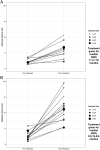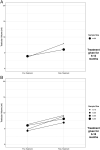Gonadotropins for pubertal induction in males with hypogonadotropic hypogonadism: systematic review and meta-analysis
- PMID: 38128110
- PMCID: PMC10773669
- DOI: 10.1093/ejendo/lvad166
Gonadotropins for pubertal induction in males with hypogonadotropic hypogonadism: systematic review and meta-analysis
Abstract
Objective: Hypogonadotropic hypogonadism is characterized by inadequate secretion of pituitary gonadotropins, leading to absent, partial, or arrested puberty. In males, classical treatment with testosterone promotes virilization but not testicular growth or spermatogenesis. To quantify treatment practices and efficacy, we systematically reviewed all studies investigating gonadotropins for the achievement of pubertal outcomes in males with hypogonadotropic hypogonadism.
Design: Systematic review and meta-analysis.
Methods: A systematic review of Medline, Embase, Global Health, and PsycINFO databases in December 2022. Risk of Bias 2.0/Risk Of Bias In Non-randomized Studies of Interventions/National Heart, Lung, and Blood Institute tools for quality appraisal. Protocol registered on PROSPERO (CRD42022381713).
Results: After screening 3925 abstracts, 103 studies were identified including 5328 patients from 21 countries. The average age of participants was <25 years in 45.6% (n = 47) of studies. Studies utilized human chorionic gonadotropin (hCG) (n = 93, 90.3% of studies), human menopausal gonadotropin (n = 42, 40.8%), follicle-stimulating hormone (FSH) (n = 37, 35.9%), and gonadotropin-releasing hormone (28.2% n = 29). The median reported duration of treatment/follow-up was 18 months (interquartile range 10.5-24 months). Gonadotropins induced significant increases in testicular volume, penile size, and testosterone in over 98% of analyses. Spermatogenesis rates were higher with hCG + FSH (86%, 95% confidence interval [CI] 82%-91%) as compared with hCG alone (40%, 95% CI 25%-56%). However, study heterogeneity and treatment variability were high.
Conclusions: This systematic review provides convincing evidence of the efficacy of gonadotropins for pubertal induction. However, there remains substantial heterogeneity in treatment choice, dose, duration, and outcomes assessed. Formal guidelines and randomized studies are needed.
Keywords: Kallmann syndrome; gonadotropins; hypogonadotropic hypogonadism; puberty; spermatogenesis.
© The Author(s) 2023. Published by Oxford University Press on behalf of European Society of Endocrinology.
Conflict of interest statement
Conflict of interest: The authors declare that there is there is no conflict of interest that could be perceived as prejudicing the impartiality of the research reported.
Figures





References
-
- Varimo T, Miettinen PJ, Känsäkoski J, Raivio T, Hero M. Congenital hypogonadotropic hypogonadism, functional hypogonadotropism or constitutional delay of growth and puberty? An analysis of a large patient series from a single tertiary center. Hum Reprod. 2017;32(1):147–153. 10.1093/humrep/dew294 - DOI - PubMed
Publication types
MeSH terms
Substances
Grants and funding
LinkOut - more resources
Full Text Sources
Medical

